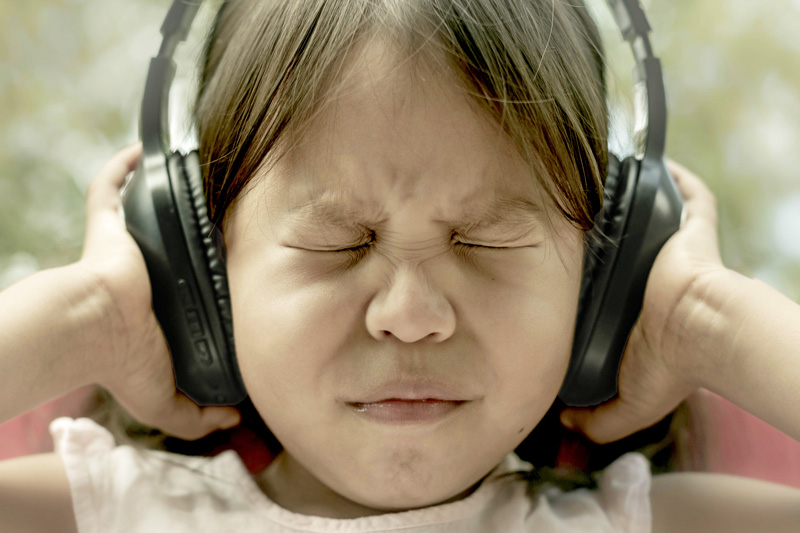What grates on your nerves? The slurping sound made by an open-mouthed eater or by someone smacking gum and popping bubbles? What about ticking clocks? Or the coworker who repeatedly clicks their pen, ad nauseam?
Why do such noises bother autistic people? Maybe it’s because stimuli and sensory processing are hard to tune out.

The Human Sensory System
Humans have eight senses in the body:
- Visual (sight)
- Auditory (hearing)
- Olfactory (smell)
- Gustatory (taste)
- Tactile (touch)
- The Vestibular System (sense of head movement in space)
- Proprioception (sensations from muscles and joints of the body)
- Interoception (knowing what is happening in your body, for example, if you are hungry, thirsty, warm, cold, etc.)
Sensory processing and regulation is a crucial process through which our nervous system integrates and adjusts sensory input, enabling us to maintain balance and optimal levels of arousal/energy. Essentially, sensory regulation involves our neurological capacity to respond to various sensory stimuli in our environment. A regulated sensory system processes and integrates sensory input to allow smooth navigation of the world around us.
The senses commonly related to sensory dysregulation are tactile, vestibular, proprioceptive, and interoception.
Sensory Processing Differences in Autism
The fifth edition of the Diagnostic and Statistical Manual of Mental Disorders (2013) was the first to include sensory processing reactivity in the diagnostic criteria for autism. It described three categories of sensory differences:
- Sensory hyper-reactivity: an over-responsiveness to sensory stimuli.
- Sensory hypo-reactivity: an under-responsiveness to stimuli.
- Sensory seeking: an excessive interest in sensory stimuli. (Rudy, 2015)
Hypersensitivity occurs when our body’s senses are overstimulated to a point where we can’t cope. Our brains are receiving more sensory information than can be processed. People experiencing sensory overload may feel irritable, anxious, or emotional. In any case, they’re in significant distress (Mount Sinai Today, 2022).
Hyposensitivity is muted responsiveness, which may result in safety concerns. Hyposensitive people may appear fearless, failing to respond to such things as the sound of an alarm, pain signals, heat and/or cold, or heedlessly running into traffic or deep bodies of water.
What Happens When an Autistic’s Senses Are Overloaded?
Too many competing sensations cause our bodies to panic to protect us from too much stimulation. To neurotypicals, panic may look like either complete withdrawal (shutdown) or a meltdown (Neff, 2023).
This sensory dysregulation is generally explained as resulting from an imbalanced central nervous system due to an excess of sensory input. Autistic people react instinctively to uncomfortable or intolerable sensory stimuli with what I liken to a fight or flight response. We may withdraw, nearly paralyzed by sensory overload. Or we may lash out in a panic that can look like aggression.
But how does this happen, and why? So far, neuroscientists only have theories, one of which is Monotropism, a theory of autism developed by autistic people.
Monotropism postulates that the human brain has an “interest-based” processing system. Autistic brains can only pay attention to a small amount of information at any given time, leaving fewer resources for other processes. It’s like our brains have “tunnel vision,” which gives rise to the often-observed special interests autistics exhibit, as well as sensory processing disorders.
Sensory Dysregulation Through the Eyes of an #ActuallyAutistic
I am an Aspie,* a high-functioning, high-masking autistic who once might have been diagnosed with Asperger’s Syndrome. As an infant, I screamed for hours each day but fought against being held. During childhood, my mother struggled to find school clothes I’d wear. Turtleneck tops made me feel as if I were a head with no body. Leggings with elastic waists were too constricting, and the fabric gave me the heebie-jeebies. Finding shoes was nearly impossible in one particularly bad year because all girls’ and women’s shoes had pointed toes. Worse than uncomfortable, there was something positively alien about them. Once puberty hit, bras felt like torture devices.
Think back to the example of the pen-clicking coworker. If you’re like me, you can’t tune out that annoying click-click-click, and you might lose it, grabbing all of their pens and pulverizing them under your well-worn Goth boots. The survival part of my brain believes it’s being attacked, resulting in an autistic meltdown.
Accommodating Autistic Sensory Processing Needs: Sensory-Friendly Environments
People on the spectrum experience the world very differently from neurotypicals. Autism presents in so many ways that accommodating every possible sensory profile is impossible. Therefore, the goal of sensory-friendly environmental design is to provide a calming and soothing space for everyone.
Autistic-friendly environments aim to reduce bright lights, excessive noise, odors, crowds, lines, and overly hot or cold environments (Accessible Environments, n.d.).
A key element of autism awareness education is “to increase public understanding of the five core features of autism and to give people [an] understanding of the actions they can take to help autistic people” (Accessible Environments, n.d.). Because if all people see is autism when they look at us, they’re missing “loving, smart, funny, sweet, insightful, unconditional, emphatic, uniquely observant, impeccably talented, ever so intelligent [people] capable of creating extraordinary change in the world” (National Autism Association, 2023; Accessible Environments, n.d.).
* While the term “Aspie” is a nickname for Asperger’s, I prefer it to autist, aspergian, person with autism, and neurodivergent. Therefore, it is the term mainly used in this article.
Annie Kent, MA, spent two decades working in public sector disability, mental health, and infectious diseases advocacy and education. Diagnosed with three closely related categories of neurodiversity, a lack of awareness and understanding led to autistic burn-out and retirement from the field. She remains an active advocate, learning and engaging remotely with several Autism and ADHD organizations and forums, including the Canadian ADHD Resource Alliance (CADDRA). For more information, visit her website, www.aspiefemmepress.ca, or email Annie at ajollymo@lakeheadu.ca.
References
Accessible environments. (n.d.). National Autistic Society. Retrieved November 29, 2023, from www.autism.org.uk/advice-and-guidance/topics/autism-friendly-guide/accessible-environments
Beck, C. (2022, October 5). Understanding Sensory Dysregulation – The OT Toolbox. The OT Toolbox. www.theottoolbox.com/understanding-sensory-dysregulation (Beck, 2022)
Bennie, M. (2016, March 7). What Is Interoception and How Does It Impact Those With Autism? – Autism Awareness. Autism Awareness. autismawarenesscentre.com/what-is-interoception-and-how-does-it-impact-autism/
Monotropism. (n.d.). Monotropism.Org. Retrieved November 29, 2023, from www.monotropism.org
Neff, M. A. (2023, May 17). The Power of Sensory Regulation. Insights of a Neurodivergent Clinician; Insights of a Neurodivergent Clinician. Reference link.
Rudy, L. J. (2015, April 10). Sensory Overload: Why It Happens and How to Deal. Verywell Health; Verywell Health. www.verywellhealth.com/autism-and-sensory-overload-259892
What Are Sensory Processing Differences and How Do They Relate to Autism? | Mount Sinai Today. (2022, April 8). Mount Sinai Today; www.facebook.com/MountSinaiNYC/. health.mountsinai.org/blog/what-are-sensory-processing-differences-and-how-do-they-relate-to-autism/
Yannaco, M. (2019, October 28). This Is What You Need to Know about Sensory Processing Disorder. SI Parent; www.facebook.com/SIParent/. www.siparent.com/explaining-sensory-processing-disorder/







[…] – Sensory Processing Through An Autistic Lens by Annie Kent, M.A.: https://autismspectrumnews.org/nurturing-comfort-sensory-processing-through-an-autistic-lens/ […]